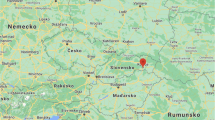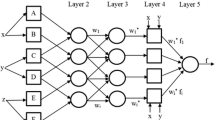Abstract
The appropriate planning and management of irrigated agriculture require accurate assessment of the ET0. To estimate the reference evapotranspiration (ET0), soft computing techniques are used. Based on the climatological data collected from the IARI regional station at Pusa for the period from 1981 to 2016, the conventional methods of Hargreaves method and FAO 56 Penman method were used to determine ET0. In order to estimate ET0, three soft computing techniques were used, i.e. support vector machine (SVM), Gaussian process regression (GPR) and artificial neural network (ANN). The reliability of these computational methods was analysed based on the coefficient of determination. In comparison to SVM and GPR computational approaches, the final result shows that ANN is the best methodology for prediction of ET0.
Access this chapter
Tax calculation will be finalised at checkout
Purchases are for personal use only
Similar content being viewed by others

References
Abdullah SS, Malek MA, Abdullah NS, Kisi O, Yap KS (2015) Extreme learning machines: a new approach for prediction of reference evapotranspiration. J Hydrol 527:184–195. https://doi.org/10.1016/j.jhydrol.2015.04.073
Adamala S, Raghuwanshi NS, Mishra A, Tiwari MK (2013) Evapotranspiration modelling using second-order neural networks. J Hydrol Eng 19(6):1131–1140. https://doi.org/10.1061/(ASCE)HE.1943-5584.0000887
Afzaal H, Farooque AA, Abbas F, Acharya B, Esau T (2020) Computation of evapotranspiration with artificial intelligence for precision water resource management. Appl Sci. https://doi.org/10.3390/app10051621
Allen RG, Pereira LS, Raes D, Smith M (1998) Crop evapotranspiration-guidelines for computing crop water requirements-FAO irrigation and drainage paper 56. FAO Rome 300(9):D05109
Blaney HF, Criddle WD (1950) Determining water requirements in irrigated areas from climatological and irrigation data. USDA Soil Cons Serv SCS-TP96, p 44. Washington D.C.
Doorenbos J, Pruitt WO (1977) Guidelines or predicting crop water requirements (FAO irrigation and drainage paper 24). Food and Agriculture Organization of the United Nations, Rome, Itely
Feng Y, Cui N, Zhao L, Hu X, Gong D (2016) Comparison of ELM, GANN, WNN and Empafzaal Irical models for estimating reference evapotranspiration in humid region of Southwest China. J Hydrol 536:376–383
Firat M (2008) Comparison of artificial intelligence techniques for river flow forecasting. Hydrol Earth Syst Sci 12:123–139
Gocić M, Motamedi S, Shamshirband S, Petković D, Ch S, Hashim R, Arif M (2015) Soft computing approaches for forecasting reference evapotranspiration. Comput Electron Agric 113:164–173
Karimaldini F, TeangShui L, Ahmed Mohamed T, Abdollahi M, Khalili N (2011) Daily evapotranspiration modelling from limited weather data by using neuro-fuzzy computing technique. J Irrig Drain Eng 138(1):21–34. https://doi.org/10.1061/(ASCE)IR.1943-4774.0000343
Kalteh AM (2013) Monthly river flow forecasting using artificial neural network and support vector regression models coupled with wavelet transform. Comput Geosci 54:1–8. https://doi.org/10.1016/j.cageo.2012.11.015
Khoob AR (2007) Comparative study of Hargreaves’s and artificial neural network’s methodologies in estimating reference evapotranspiration in a semiarid environment. Irrig Sci 26:253–259
Khoob AR (2008) Artificial neural network estimation of reference evapotranspiration from pan evaporation in a semi-arid environment. Irrig Sci 27(1):35–39. https://doi.org/10.1007/s00271-008-0119-y
Kisi O (2009) Fuzzy genetic approach for modeling reference evapotranspiration. J Irrig Drain Eng 136(3):175–183
Kumar M, Raghuwanshi NS, Singh R, Wallender WW, Pruitt WO (2002) Estimating evapotranspiration using artificial neural network. J Irrig Drain Eng 128:224–233. https://doi.org/10.1061/(ASCE)0733-9437(2002)128:4(224)
Kumar M, Raghuwanshi NS, Singh R (2011) Artificial neural networks approach in evapotranspiration modelling: a review. Irrig Sci 29:11–25
Lu W-Z, Wang W-J (2005) Potential assessment of the “support vector machine” method in forecasting ambient air pollutant trends. Chemosphere 59(5):693–701. https://doi.org/10.1016/j.chemosphere.2004.10.032
Mehdizadeh S, Behmanesh J, Khalili K (2017) Using MARS, SVM, GEP and empirical equations for estimation of monthly mean reference evapotranspiration. Comput Electron Agric 139:103–114. https://doi.org/10.1016/j.compag.2017.05.002
Patil AP, Deka PC (2016) An extreme learning machine approach for modeling evapotranspiration using extrinsic inputs. Comput Electron Agric 121:385–392. https://doi.org/10.1016/j.compag.2016.01.016
Pereira LS, Allen RG, Smith M, Raes D (2015) Crop evapotranspiration estimation with FAO56: past and future. Agric Water Manage 147:4–20. https://doi.org/10.1016/j.agwat.2014.07.031
Vapnik VN, Golowich SE, Smola A (1997) Support vector method for function approximation, regression estimation, and signal processing. Adv Neural Inf Process Syst 281–287
Wang J (2005) Carbon‐nanotube based electrochemical biosensors: A review. Electroanalysis: Int J Devoted Fundam Pract Aspects Electroanalysis 17(1):7–14
Wang YM, Namaona W, Traore S, Zhang ZC (2009) Seasonal temperature-based models for reference evapotranspiration estimation under semi-arid condition of Malawi. Afr J Agric Res 4(9):878–886
Author information
Authors and Affiliations
Corresponding author
Editor information
Editors and Affiliations
Rights and permissions
Copyright information
© 2022 The Author(s), under exclusive license to Springer Nature Singapore Pte Ltd.
About this paper
Cite this paper
Roy, L.B., Praveen, K. (2022). Study of ET0 by Using Soft Computing Techniques in the Eastern Gandak Project in Bihar, India—A Case Study. In: Kumar, R., Ahn, C.W., Sharma, T.K., Verma, O.P., Agarwal, A. (eds) Soft Computing: Theories and Applications. Lecture Notes in Networks and Systems, vol 425. Springer, Singapore. https://doi.org/10.1007/978-981-19-0707-4_47
Download citation
DOI: https://doi.org/10.1007/978-981-19-0707-4_47
Published:
Publisher Name: Springer, Singapore
Print ISBN: 978-981-19-0706-7
Online ISBN: 978-981-19-0707-4
eBook Packages: Intelligent Technologies and RoboticsIntelligent Technologies and Robotics (R0)



